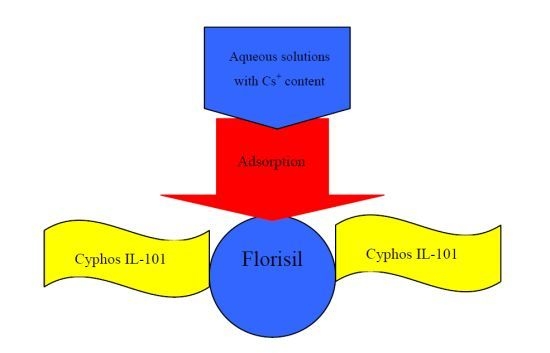Cs+ Removal from Aqueous Solutions through Adsorption onto Florisil® Impregnated with Trihexyl(tetradecyl)phosphonium Chloride
Abstract
:1. Introduction
2. Results and Discussion
2.1. Characterization of the Florisil® Impregnated with IL
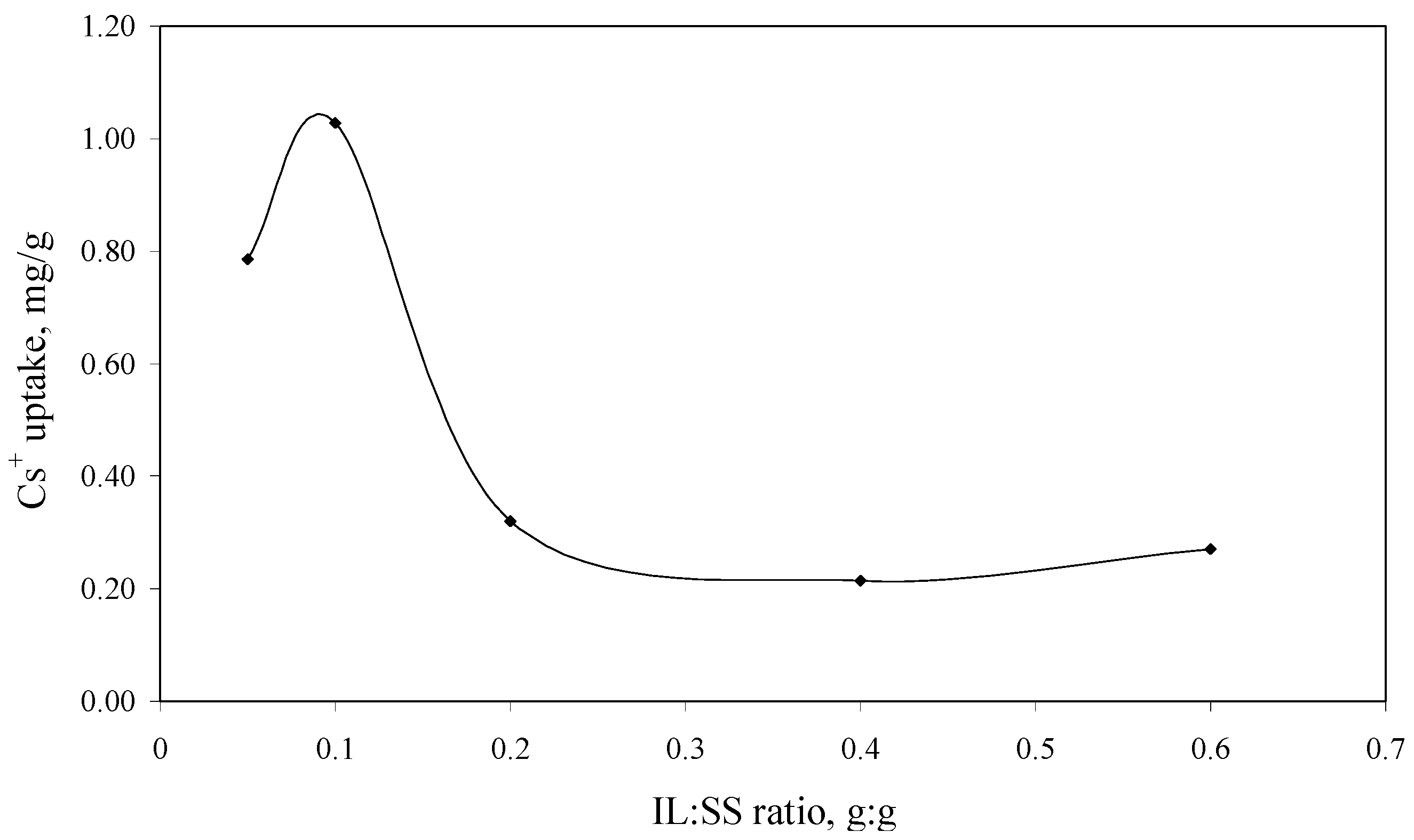
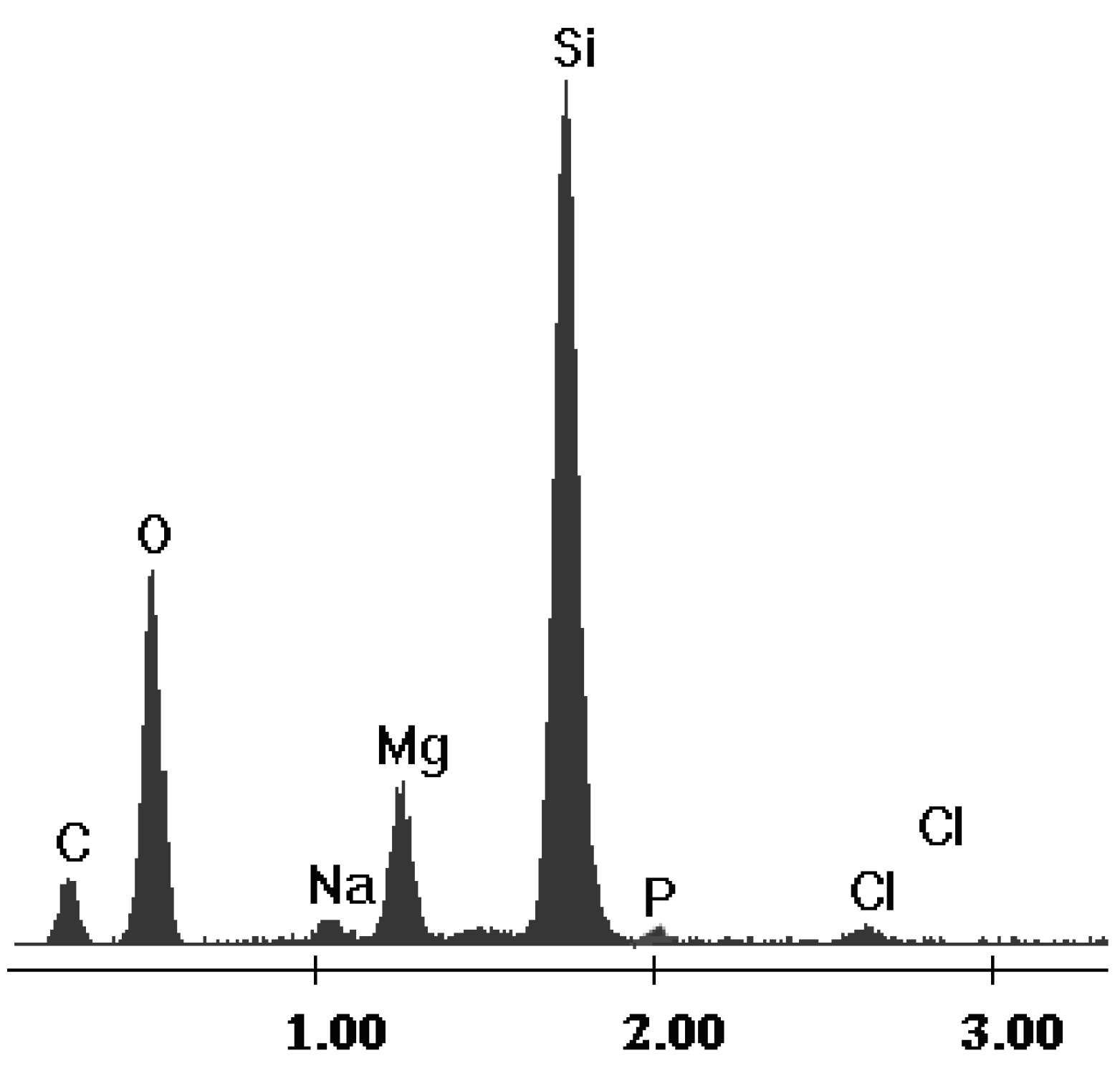
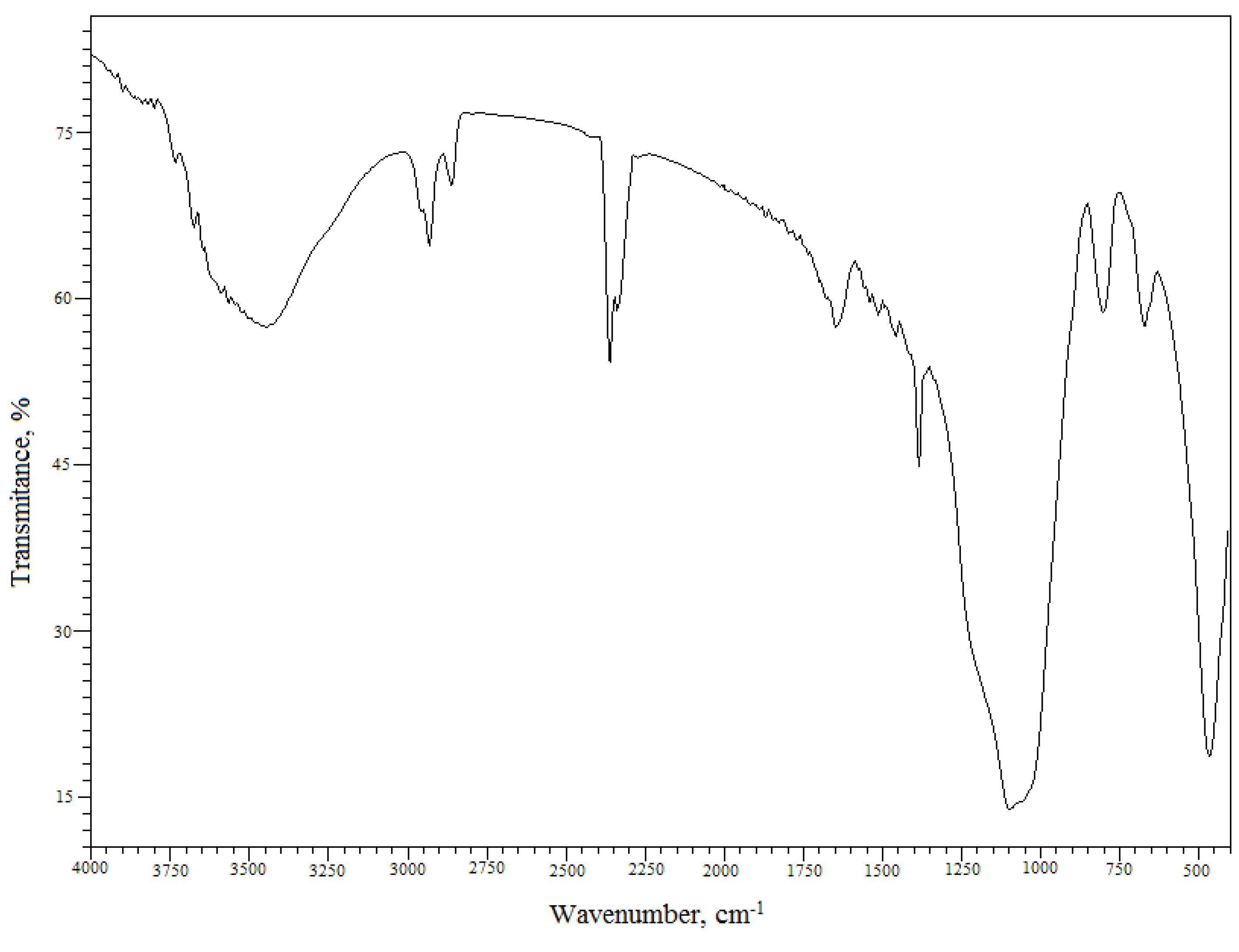
| Wavenumber [cm–1] | Assignments |
|---|---|
| 3,455 (s,b) | νOH bonded ν(Cs-OH, Cs-OH2) |
| 2,957 (w) | νa (CH3) |
| 2,933 (w) | νa (CH2) |
| 2,858 (w) | νs (CH3) |
| 1,395 (m) | P-C stretching νs (CH2) |
| 1,100 (vs) | P-C stretching νa (C-C) |
| 1,050 (vs) | P-C stretching ν (M-O) |
| 800 (w) | P-C deformation (out of the plane) ν (M-O) |
| 670 (w) | ν (Si-O) |
| 465 (s) | ν (M-O) |
2.2. pH Influence on the Cs+ Adsorption Process
2.3. Influence of the Amount of Impregnated Florisil® on the Cs+ Adsorption Process
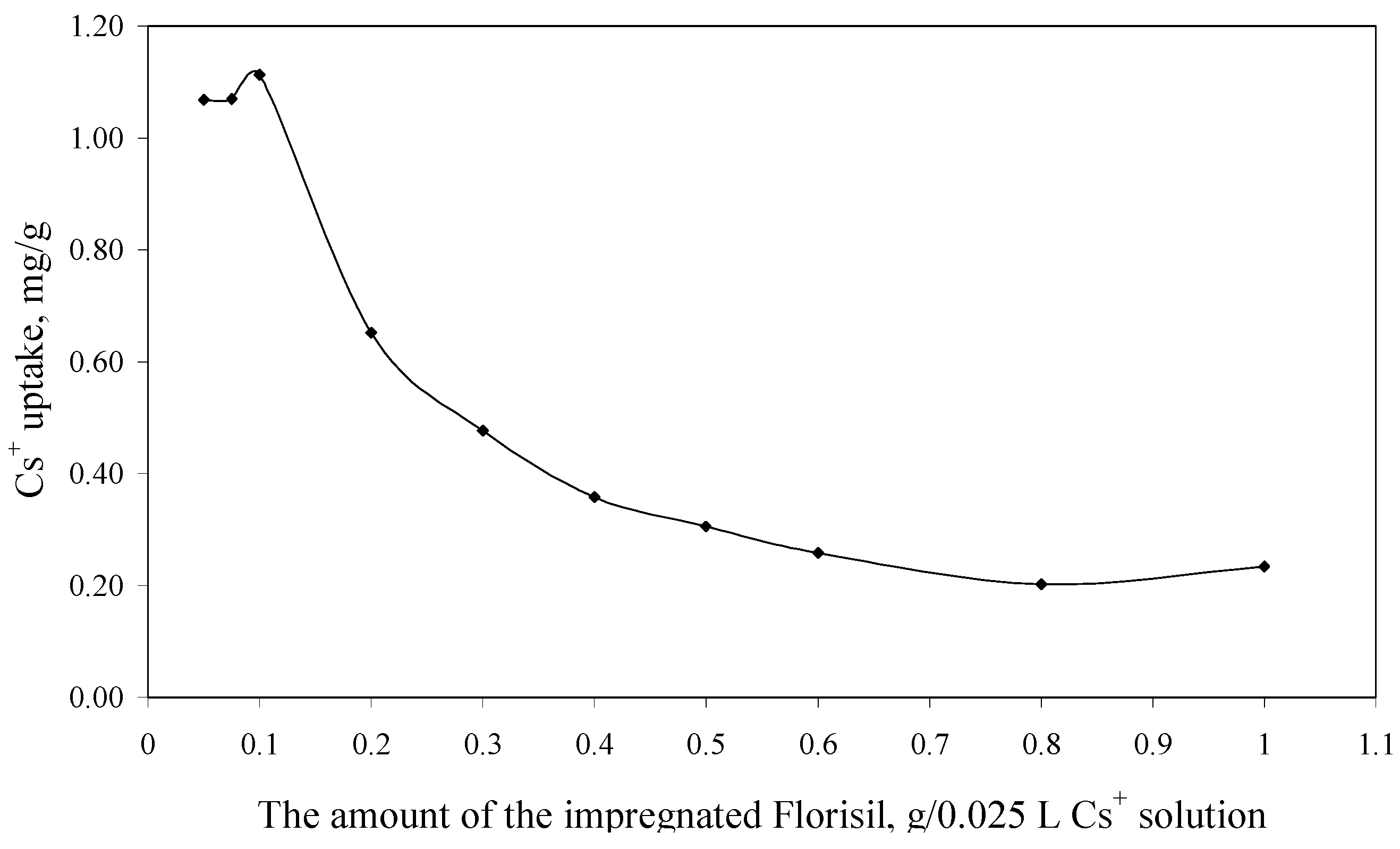
2.4. Adsorption Isotherm
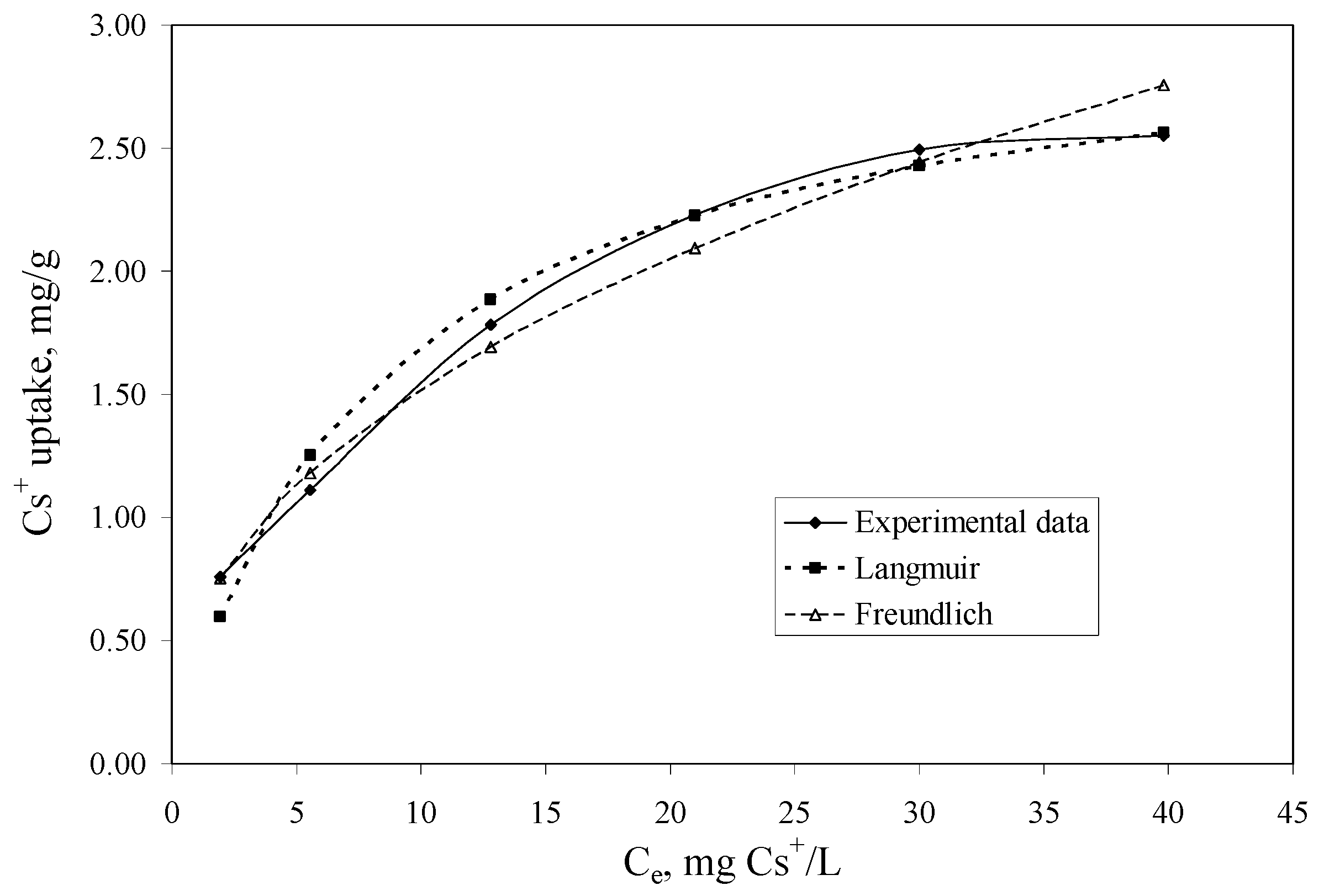
| Langmuir isotherm | Freundlich isotherm | ||||||
|---|---|---|---|---|---|---|---|
| qm, exp mg/g | KL L/mg | qm, calc mg/g | R2 | KF mg/g | 1/n | R2 | |
| 2.6 | 0.123 | 3.086 | 0.9907 | 0.5658 | 0.4299 | 0.9863 | |
2.5. The Influence of Contact Time and Temperature on the Cs+ Adsorption Process and Adsorption Kinetics
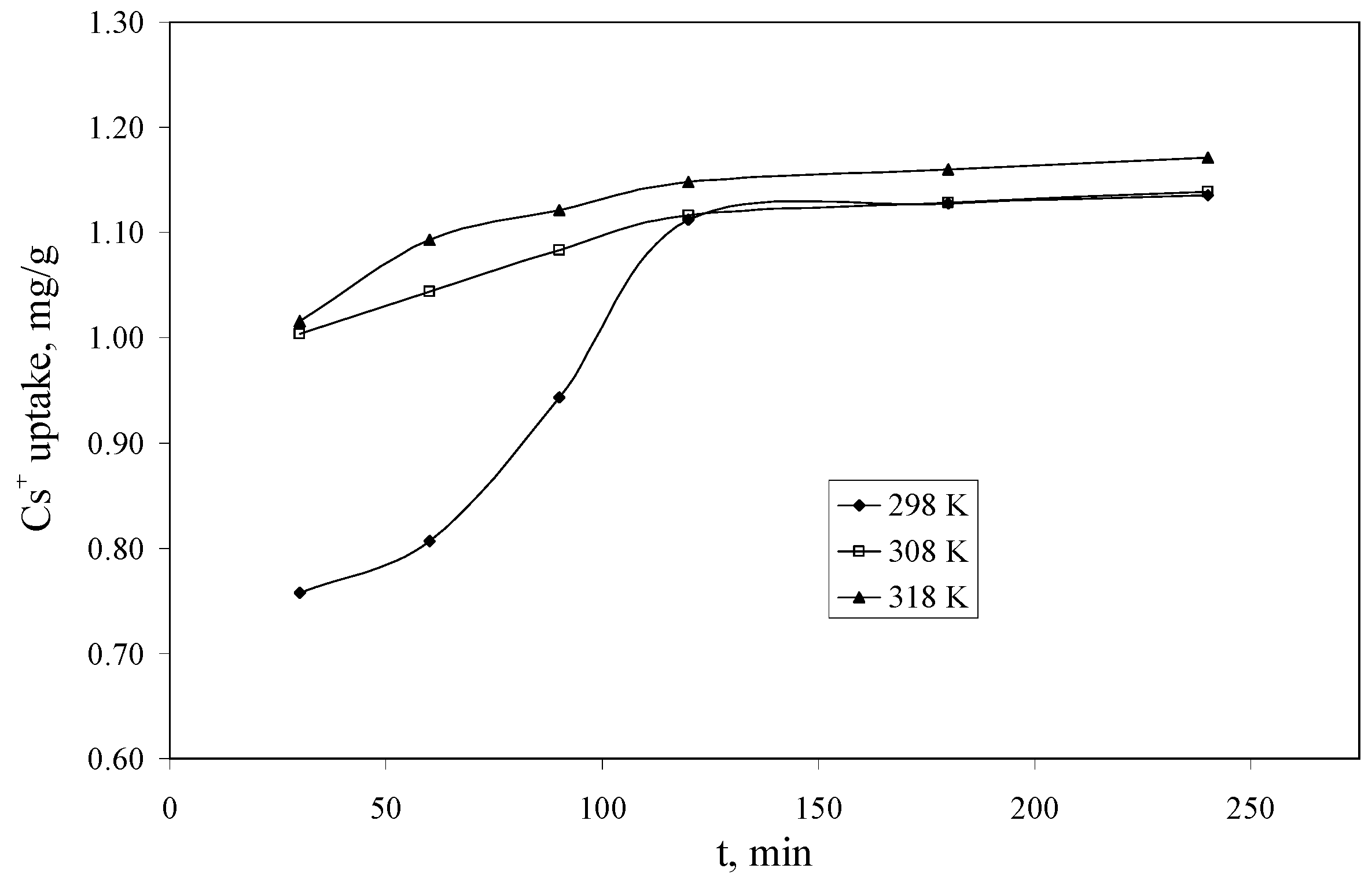
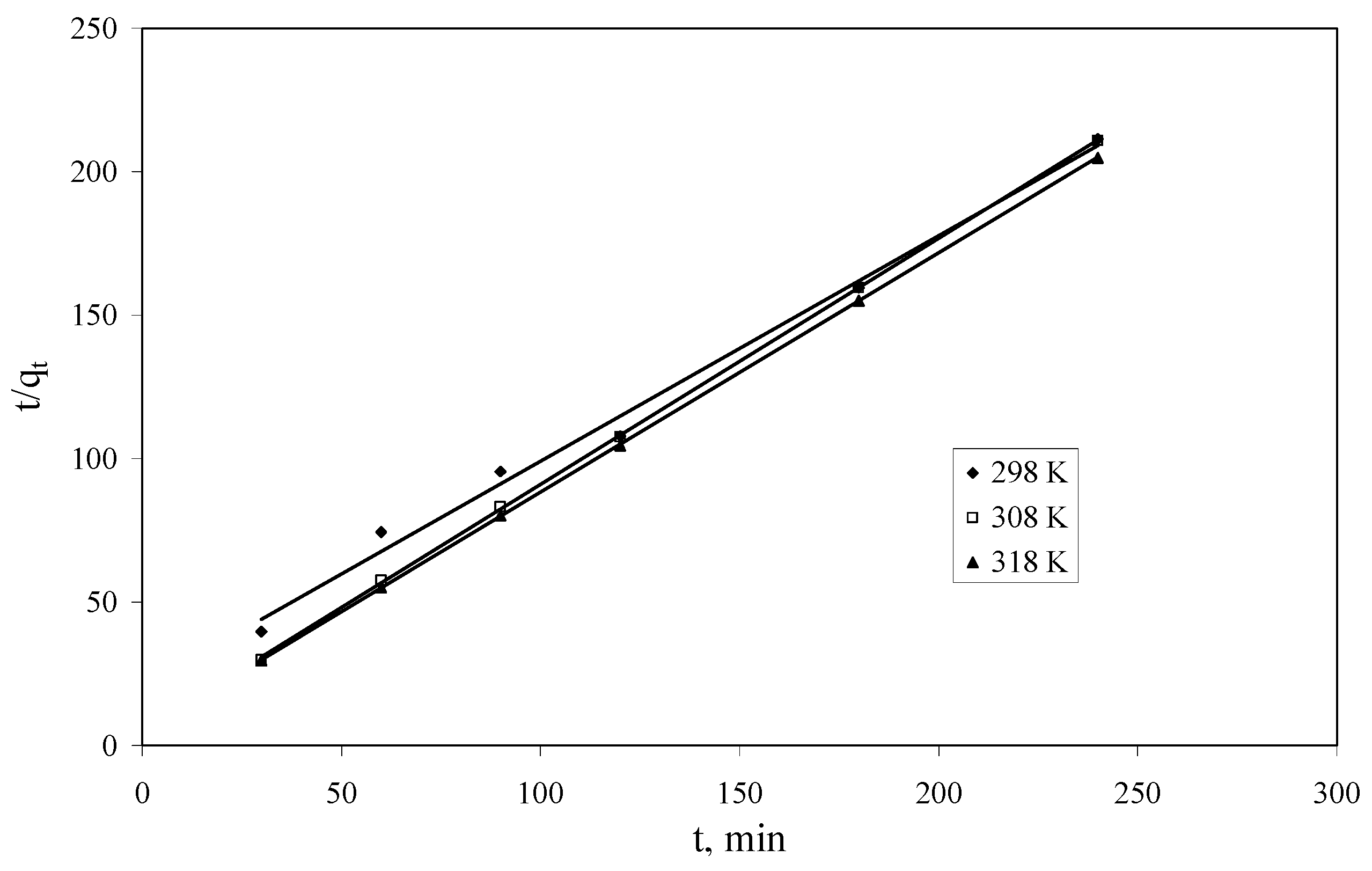
| Temperature, K | Parameter | |||
|---|---|---|---|---|
| qe, exp, mg/g | qe, calc, mg/g | k2, g/(min℘mg) | R2 | |
| 298 | 1.15 | 1.27 | 0.0304 | 0.9926 |
| 308 | 1.15 | 1.16 | 0.144 | 0.9999 |
| 318 | 1.18 | 1.20 | 0.146 | 1 |
3. Experimental
3.1. Materials
3.2. Preparation and Characterization of the Florisil® Impregnated with IL
3.3. Adsorption Experiments
4. Conclusions
Acknowledgments
Conflicts of Interest
References
- Nilchi, A.; Saberi, R.; Moradi, M.; Azizpour, H.; Zarghami, R. Adsorption of caesium on copper hexacyanoferrate-PAN composite ion exchanger from aqueous solution. Chem. Eng. J. 2011, 172, 572–580. [Google Scholar] [CrossRef]
- El-Kamash, A.M. Evaluation of zeolite A for the sorptive removal of Cs+ and Sr2+ ions from aqueous solutions using batch and fixed bed columns operations. J. Hazard. Mater. 2008, 151, 432–445. [Google Scholar] [CrossRef]
- Abd El-Latif, M.-M.; Elkady, M.-M. Kinetics study and thermodynamic behaviour for removing cesium, cobalt and nickel ions from aqueous solution using nano-zirconiuim vanadate ion exchange. Desalination 2011, 271, 41–54. [Google Scholar]
- Vendilo, A.G.; Djigailo, D.I.; Smirnova, S.V.; Torocheshnikova, I.I.; Popov, K.I.; Krasovsky, V.G.; Pletnev, I.V. 18-Crown-6 and dibenzo-18-crown-6 assisted extraction of cesium from water into room temperature ionic liquids and its correlation with stability constants for cesium complexes. Molecules 2009, 14, 5001–5016. [Google Scholar] [CrossRef]
- Xu, J.Z.; Rajapkse, N.; Finston, H.L. Homogeneous liquid-liquid extraction of Uranium from fission-products. Radiochim. Acta 1990, 49, 135–140. [Google Scholar]
- Murata, K.; Ikeda, S.; Yokoyama, Y. Homogeneous liquid-liquid extraction method-Extraction of Iron(III) thenoyltifluoroacetonate by propylene carbonate. Anal. Chem. 1972, 44, 805–810. [Google Scholar] [CrossRef]
- Preston, J.S. Solvent extraction of metals by carboxylic-acids. Hydrometallurgy 1985, 14, 805–810. [Google Scholar] [CrossRef]
- Hoogerstraete, T.V.; Onghena, B.; Binnemans, K. Homogeneous liquid-liquid extraction of metal ions with a functionalized ionic liquid. J. Phys. Chem. Lett. 2013, 4, 1659–1663. [Google Scholar] [CrossRef]
- Ha, S.H.; Menchavez, R.N.; Koo, Y.M. Reprocessing of spent nuclear waste using ionic liquids. Korean J. Chem. Eng. 2010, 27, 1360–1365. [Google Scholar] [CrossRef]
- Fraser, K.J.; MacFarlane, D.R. Phosphonium-based ionic liquids: An overview. Aust. J. Chem. 2009, 62, 309–321. [Google Scholar] [CrossRef]
- Yang, X.Y.; Zhang, J.P.; Guo, L.; Zhao, H.; Zhang, Y.; Chen, J. Solvent impregnated resin prepared using ionic liquid Cyphos IL 104 for Cr(VI) removal. Trans. Nonferr. Met. Soc. China 2012, 22, 3126–3130. [Google Scholar] [CrossRef]
- Stojanovic, A.; Morgenbesser, C.; Kogelnig, D.; Krachler, R.; Keppler, B.D. Quaternary Ammonium and Phosphonium Ionic Liquids in Chemical and Environmental Engineering, Ionic Liquids: Theory, Properties, New Approaches; Kokorin, A., Ed.; Publisher: Rijeka, Croatia, 2011; pp. 657–680. [Google Scholar]
- Martak, J.; Schlosser, S. Extraction of lactic acid by phosphonium ionic liquid. J. Sep. Purif. Technol. 2007, 57, 483–494. [Google Scholar] [CrossRef]
- Liu, Y.; Zhu, L.; Sun, X.; Chen, J.; Luo, F. Silica materials doped with bifunctional ionic liquid extractants for Yttrium extraction. Ind. Eng. Chem. Res. 2009, 48, 7308–7313. [Google Scholar] [CrossRef]
- Liu, Y.; Zhu, L.; Sun, X.; Chen, J. Toward greener separations of rare earths: Bifunctional ionic liquid extractants in biodiesel. AlChE J. 2010, 56, 2338–2346. [Google Scholar]
- Guo, L.; Liu, Y.; Zhang, C.; Chen, J. Preparation of PVDF-based polymer inclusion memebrane using ionic liquid plasticizer and Cyphos IL 104 carrier for Cr(VI) transport. J. Membr. Sci. 2011, 372, 314–321. [Google Scholar] [CrossRef]
- Guibal, E.; Pinol, A.-F.; Ruz, M.; Vincent, T.; Jounanin, C.; Sastre, A. Immobilization of Cyphos ionic liquids in alginate capsules for Cd(II) sorption. Sep. Sci. Technol. 2010, 45, 1935–1949. [Google Scholar] [CrossRef]
- Campos, K.; Domingo, R.; Vincent, T.; Ruiz, M.; Sastre, A.M.; Guibal, E. Bismuth recovery from acidic solutions using Cyphos IL-101 immobilized in a composite biopolymer matrix. Water Res. 2008, 42, 4019–4031. [Google Scholar] [CrossRef]
- Gallardo, V.; Navarro, R.; Saucedo, I.; Avila, M.; Guibal, E. Zinc(II) extraction from hydrochloric acid solutions using Amberlite XAD7 impregnated with Chyphos IL101 (tetradecyl(trihexyl) phosphonium chloride). Sep. Sci. Technol. 2008, 43, 2434–2459. [Google Scholar] [CrossRef]
- Vincent, T.; Parodi, A.; Guibal, E. Pt recovery using Cypos IL-101 immobilized in biopolymer capsule. Sep. Purif. Technol. 2008, 62, 470–479. [Google Scholar] [CrossRef]
- Regel-Rosocka, M.; Wisniewski, M. Selective removal of znic(II) from spent pickling solutions in the presence of iron ions with phosphonium ionic liquid Cyphos IL101. Hydrometallurgy 2011, 110, 85–90. [Google Scholar] [CrossRef]
- Todd, T.A.; Mann, N.R.; Tranter, T.J.; Sebesta, F.; John, J.; Motl, A. Cesium sorption from concentrated acidic tank wastes using ammonium molybdophosphate-polyacrylonitrile composite sorbents. J. Radioanal. Nucl. Chem. 2002, 254, 47–52. [Google Scholar] [CrossRef]
- Tranter, T.J.; Herbst, R.S.; Todd, T.A.; Olson, A.L.; Eldredge, H.B. Evaluation and testing of ammonium molybdophosphate-polyacrylonitrile (AMP-PAN) as a cesium selective sorbent for the removal of cesium-137 from INTEC acidic waste. Adv. Environ. Res. 2002, 6, 107–121. [Google Scholar] [CrossRef]
- Zhu, L.; Guo, L.; Zhang, Z.; Chen, J.; Zhang, S. The preparation of supported ionic liquids (SILs) and their application in rare metals separation. Sci. China Chem. 2012, 55, 1479–1487. [Google Scholar] [CrossRef]
- Sun, X.; Preng, B.; Ji, Y.; Chen, J.; Li, D. The solid-liquid extraction of yttrium from rare earths by solvent (ionic liquid) impregnated resin coupled with complexing method. Sep. Purif. Technol. 2008, 63, 61–68. [Google Scholar] [CrossRef]
- Sun, X.Q.; Xu, A.M.; Chen, J.; Li, D.Q. Application of room temperature ionic liquid-based extraction for metal ions. Chin. J. Anal. Chem. 2007, 35, 597–604. [Google Scholar]
- Sun, X.; Li, Y.; Chen, J.; Ma, J. Solvent impregnated resin prepared using task-specific ionic liquids for rare earth separation. J. Rare Earth 2009, 27, 932–936. [Google Scholar] [CrossRef]
- Mahmoud, M.E. Surface loaded 1-methyl-3-ethylimidazolium bis(trifluoromethylsulfonyl)imide [EMIM+Tf2N−] hydrophobic ionic liquid on nano-Silica sorbents for removal of lead from water samples. Desalination 2011, 266, 119–127. [Google Scholar] [CrossRef]
- Kalidhasan, S.; Kumar, A.-S.-K.; Rajesh, V.; Rajesh, N. An efficient ultrasound assisted approach for the impregnation of room temperature ionic liquid onto Dowex 1 × 8 resin matrix and its application toward the enhanced adsorption of Cr(VI). J. Hazard. Mater. 2012, 213–214, 249–257. [Google Scholar] [CrossRef]
- Lemus, J.; Palomar, J.; Gilarranz, M.; Rodriquez, J. Characterization of supported ionic liquid phase (SILP) materials prepared from different supports. Adsorption 2011, 17, 561–571. [Google Scholar] [CrossRef]
- Zhang, A.; Wang, W.; Chai, Z.; Kuraoka, E. Modification of a novel macroporous Silica-based Crown ether impregnated polymeric composite with 1-dodecanol and its adsorption for some fission and non-fission product contained in high level liquid waste. Eur. Polym. J. 2008, 44, 3899–3907. [Google Scholar] [CrossRef]
- Negrea, A.; Ciopec, M.; Lupa, L.; Negrea, P.; Gabor, A. Influence of the solid support base impregnated with IL on the sorption of various radionuclides from aqueous solutions. AWERProcedia Adv. Appl. Sci. 2013, 1, 241–250. [Google Scholar]
- Cholico-Gonzalez, D.; Avila-Rodriguez, M.; Cote, G.; Chagnes, A. Chemical properties of trihexyl(tetradecyl)phosphonium chloride and bis(2,4,4-trimethylpentyl)phosphinic acid mixtures: Interaction study by FT-IR and NMR spectroscopies. J. Mol. Liq. 2013, 187, 165–170. [Google Scholar] [CrossRef]
- Plinio, I. Infrared spectroscopy of sol-gel derived silica-based films: A spectra-microstructure overview. J. Non-Cryst. Solids 2013, 316, 309–319. [Google Scholar]
- Nakamoto, K. Infrared Spectra of Inorganic and Coordination Compounds, 4th ed.; A Wiley-Interscience Publishers John Wiley & Sons: New York, NY, USA, 1968. [Google Scholar]
- Sinha, P.K.; Panicker, P.K.; Amalraj, R.V. Treatment of radioactive liquid waste containing caesium by indigenously available synthetic zeolites: A comparative study. Waste Manag. 1995, 15, 149–157. [Google Scholar] [CrossRef]
- Hassan, N.M.; Adu-Wusu, K. Cesium removal from Hanford tank waste solution using resorcinol-formaldehyde resin. Solvent Extr. Ion Exch. 2005, 23, 375–389. [Google Scholar] [CrossRef]
- Miah, M.Y.; Volchek, K.; Kuang, W.; Tezel, F.H. Kinetic and equilibrium studies of cesium adsorption on ceiling tiles from aqueous solutions. J. Hazard. Mater. 2010, 183, 712–717. [Google Scholar] [CrossRef]
- Haladi, N.; Kananpanah, S.; Abolghasemi, H. Equilibrium and thermodynamic studies of cesium adsorption on natural Vermiculite and optimization of the operation conditions. Iran. J. Chem. Chem. Eng. 2009, 28, 29–36. [Google Scholar]
- Negrea, A.; Ciopec, M.; Lupa, L.; Davidescu, C.M.; Popa, A.; Ilia, G.; Negrea, P. Removal of AsV by FeIII—loaded XAD7 impregnated resin containing di(2-ethylhexyl) phosphoric acid (DEHPA): Equilibrium, kinetic, and thermodynamic modeling studies. J. Chem. Eng. Data 2011, 56, 3830–3838. [Google Scholar] [CrossRef]
- Sample Availability: Samples of the Florisil® impregnated with Cyphos IL 101 are available from the authors.
© 2013 by the authors; licensee MDPI, Basel, Switzerland. This article is an open access article distributed under the terms and conditions of the Creative Commons Attribution license (http://creativecommons.org/licenses/by/3.0/).
Share and Cite
Lupa, L.; Negrea, A.; Ciopec, M.; Negrea, P. Cs+ Removal from Aqueous Solutions through Adsorption onto Florisil® Impregnated with Trihexyl(tetradecyl)phosphonium Chloride. Molecules 2013, 18, 12845-12856. https://doi.org/10.3390/molecules181012845
Lupa L, Negrea A, Ciopec M, Negrea P. Cs+ Removal from Aqueous Solutions through Adsorption onto Florisil® Impregnated with Trihexyl(tetradecyl)phosphonium Chloride. Molecules. 2013; 18(10):12845-12856. https://doi.org/10.3390/molecules181012845
Chicago/Turabian StyleLupa, Lavinia, Adina Negrea, Mihaela Ciopec, and Petru Negrea. 2013. "Cs+ Removal from Aqueous Solutions through Adsorption onto Florisil® Impregnated with Trihexyl(tetradecyl)phosphonium Chloride" Molecules 18, no. 10: 12845-12856. https://doi.org/10.3390/molecules181012845



